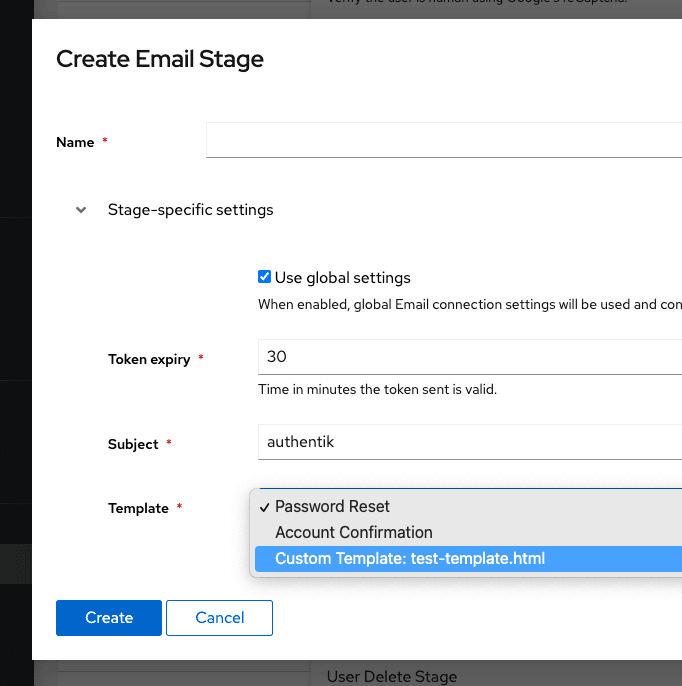Email stage
This stage can be used for email verification. authentik's background worker will send an email using the specified connection details.
When an email can't be delivered, authentik automatically retries periodically.
You can also configure rate-limiting for emails requested by users. See the configure rate limiting section for more information.
For information about creating a stage, refer to our documentation.
Behaviour
By default, the email is sent to the currently pending user. To override this, you can set email in the plan's context to another email address, which will override the user's email address (the user won't be changed).
For example, create this expression policy and bind it to the email stage:
request.context["flow_plan"].context["email"] = "foo@bar.baz"
# Or get it from a prompt
# request.context["flow_plan"].context["email"] = request.context["prompt_data"]["email"]
# Or another user attribute
# request.context["flow_plan"].context["email"] = request.context["pending_user"].attributes.get("otherEmail")
return True
Configure rate limiting for emails
You can configure the Email stage with a maximum number of emails that can be sent within a specified time period.
To configure the rate limiting for recovery emails use these two fields when you create or edit an Email stage:
- Account Recovery Max Attempts: set the maximum number of emails to send.
- Account Recovery Cache Timeout: specify the time window used to count recent recovery emails sent to the user (account recovery attempts).
Custom Templates
You can also use custom email templates, to use your own design or layout.
Starting with authentik 2024.2, it is possible to create .txt files with the same name as the .html template. If a matching .txt file exists, the email sent will be a multipart email with both the text and HTML template.
- Docker Compose
- Kubernetes
Place any custom templates in the custom-templates Folder, which is in the same folder as your Compose file. Afterwards, you'll be able to select the template when creating/editing an Email stage.
Create a ConfigMap with your email templates:
apiVersion: v1
kind: ConfigMap
metadata:
name: authentik-templates
namespace: authentik
data:
my-template.html: |
<tr>...
Then, in the helm chart add this to your values.yaml file:
volumes:
- name: email-templates
configMap:
name: authentik-templates
volumeMounts:
- name: email-templates
mountPath: /templates
If you have added the line and created a file, and can't see it, check the worker logs using docker compose logs -f worker or kubectl logs -f deployment/authentik-worker.

Example template
Templates are rendered using Django's templating engine. The following variables can be used:
url: The full URL for the user to click onuser: The pending user object.expires: The timestamp when the token expires.
{# This is how you can write comments which aren't rendered. #}
{# Extend this template from the base email template, which includes base layout and CSS. #}
{% extends "email/base.html" %}
{# Load the internationalization module to translate strings, and humanize to show date-time #}
{% load i18n %}
{% load humanize %}
{# The email/base.html template uses a single "content" block #}
{% block content %}
<tr>
<td class="alert alert-success">
{% blocktrans with username=user.username %} Hi {{ username }},
{% endblocktrans %}
</td>
</tr>
<tr>
<td class="content-wrap">
<table width="100%" cellpadding="0" cellspacing="0">
<tr>
<td class="content-block">
{% trans 'You recently requested to change your password for you authentik account. Use the button below to set a new password.' %}
</td>
</tr>
<tr>
<td class="content-block">
<table
role="presentation"
border="0"
cellpadding="0"
cellspacing="0"
class="btn btn-primary"
>
<tbody>
<tr>
<td align="center">
<table
role="presentation"
border="0"
cellpadding="0"
cellspacing="0"
>
<tbody>
<tr>
<td>
<a
id="confirm"
href="{{ url }}"
rel="noopener noreferrer"
target="_blank"
>{% trans 'Reset Password' %}</a
>
</td>
</tr>
</tbody>
</table>
</td>
</tr>
</tbody>
</table>
</td>
</tr>
<tr>
<td class="content-block">
{% blocktrans with expires=expires|naturaltime %}
If you did not request a password change, please ignore this Email. The link above is valid for {{ expires }}.
{% endblocktrans %}
</td>
</tr>
</table>
</td>
</tr>
{% endblock %}